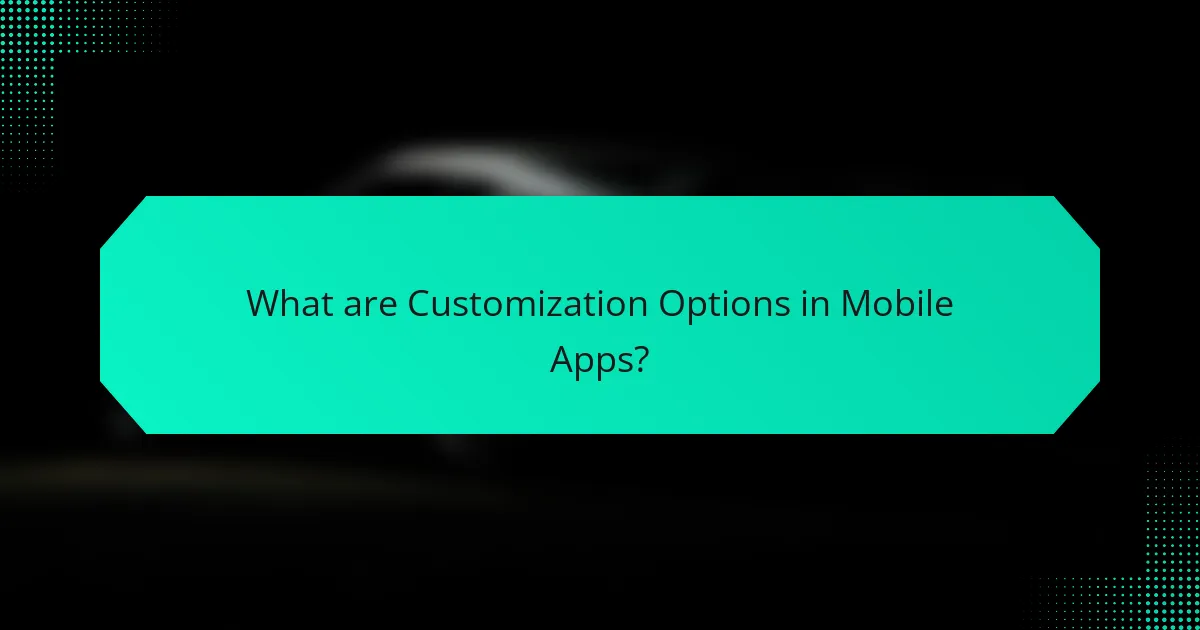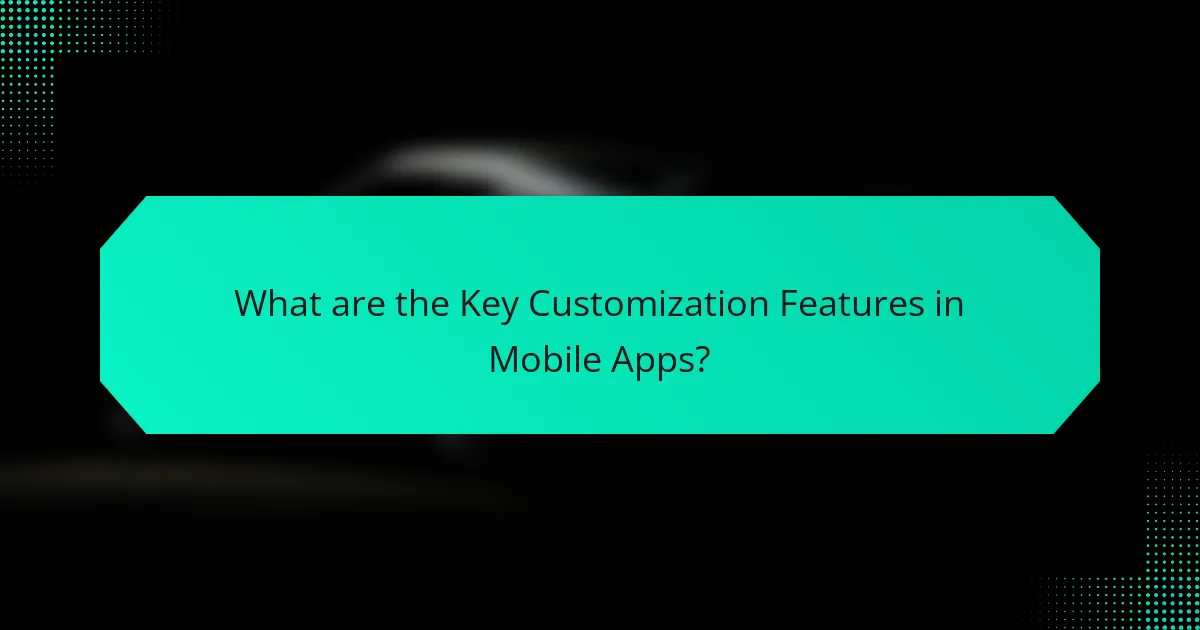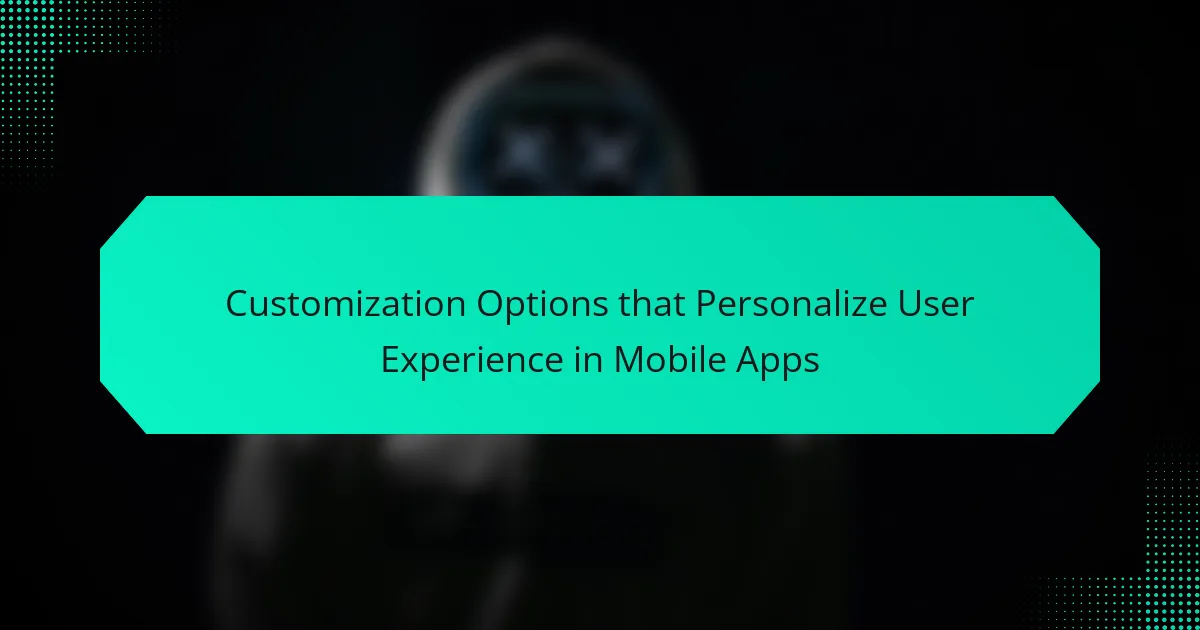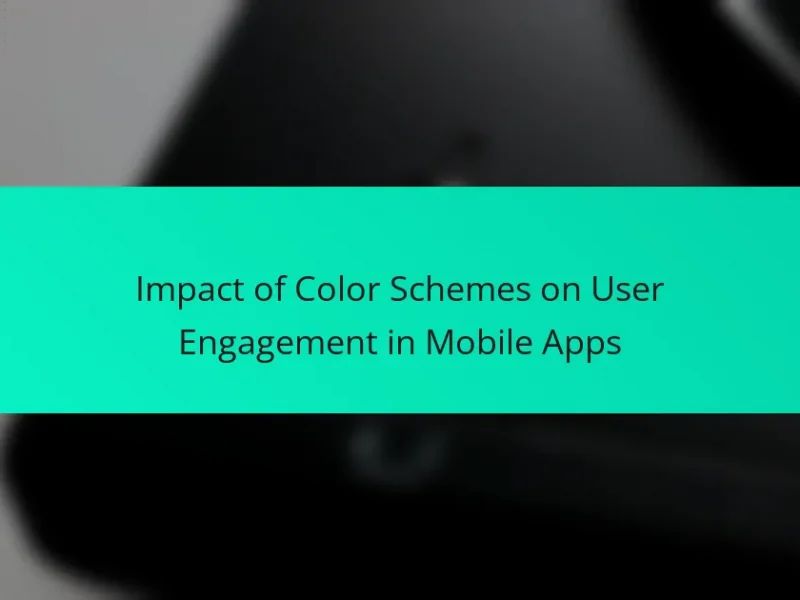Customization options in mobile apps refer to the features that allow users to personalize their experience based on individual preferences. Key aspects of these options include user interface personalization, notification settings, and content preferences, which together enhance user engagement and satisfaction. Research indicates that tailored experiences can improve user retention by up to 30%. Technological advancements, such as data analytics and artificial intelligence, enable more intuitive and user-friendly customization, allowing apps to provide personalized content and recommendations. The increasing availability of APIs further expands the potential for customized experiences across various platforms.

What are Customization Options in Mobile Apps?
Customization options in mobile apps allow users to tailor their experience according to personal preferences. These options may include themes, layouts, and color schemes. Users can often adjust notification settings to control alerts. Font sizes and styles may also be customizable for better readability. Many apps provide functionality to rearrange or hide features based on user needs. Some apps enable users to create personalized profiles or dashboards. Customization enhances user engagement and satisfaction. Research indicates that personalized experiences can increase user retention by up to 30%.
How do Customization Options enhance User Experience?
Customization options enhance user experience by allowing users to tailor applications to their preferences. This personalization increases engagement and satisfaction. Users can modify settings, layouts, and features according to their needs. A study by Forrester Research found that 77% of consumers prefer personalized experiences. Customization also fosters a sense of ownership and control. This leads to increased loyalty and retention. Furthermore, personalized interfaces can improve usability and efficiency. Overall, customization options create a more relevant and enjoyable user experience.
What types of Customization Options are available in Mobile Apps?
Customization options in mobile apps include themes, layouts, and functionality settings. Users can select different themes to change the visual appearance of the app. Layout customization allows users to rearrange elements according to their preferences. Functionality settings enable users to adjust features such as notifications and privacy options. Some apps offer personalized content based on user behavior. Additionally, users can often customize their profiles with unique avatars or bios. Customization enhances user engagement and satisfaction. Research shows that personalized experiences lead to higher retention rates in mobile applications.
How do Customization Options impact user engagement and satisfaction?
Customization options significantly enhance user engagement and satisfaction. These options allow users to tailor their experience according to personal preferences. When users can customize features, they feel a greater sense of ownership. This ownership leads to increased interaction with the app. A study by Forrester Research found that personalization can improve user satisfaction by up to 20%. Additionally, apps that offer customization options see higher retention rates. Users are more likely to return to an app that meets their individual needs. Overall, customization fosters a more engaging and satisfying user experience.
Why is Personalization important in Mobile Apps?
Personalization is important in mobile apps because it enhances user engagement and satisfaction. Personalized experiences cater to individual user preferences and behaviors. This leads to increased retention rates and higher user loyalty. Studies show that 80% of consumers are more likely to make a purchase when brands offer personalized experiences. Additionally, personalization can improve app usability by streamlining navigation and content delivery. Tailored recommendations can guide users to relevant features, increasing overall app usage. In summary, personalization in mobile apps directly contributes to better user experiences and business outcomes.
What psychological factors drive the need for personalized experiences?
The psychological factors driving the need for personalized experiences include the desire for autonomy, self-expression, and social validation. Autonomy refers to the need for individuals to feel in control of their choices. Personalized experiences empower users to make selections that reflect their preferences. Self-expression allows individuals to showcase their identities through customized content. This personalization fosters a sense of belonging and uniqueness. Social validation is influenced by the need for acceptance within a community. Personalized experiences can enhance social interactions by aligning with shared interests. Research indicates that personalization increases user engagement, as users are more likely to interact with content that resonates with them. A study by the Journal of Consumer Research found that personalized marketing significantly increases consumer satisfaction and loyalty.
How does personalization influence user retention rates?
Personalization significantly enhances user retention rates. Personalized experiences make users feel valued and understood. Research shows that 80% of consumers are more likely to make a purchase when brands offer personalized experiences. Tailored content increases engagement, leading to longer app usage. Users are more likely to return to apps that remember their preferences. This creates a sense of loyalty, further boosting retention. Additionally, personalized recommendations can increase user satisfaction. Satisfied users are less likely to abandon an app, resulting in improved retention metrics.

What are the Key Customization Features in Mobile Apps?
Key customization features in mobile apps include user interface personalization, notification settings, and content preferences. User interface personalization allows users to modify themes, fonts, and layouts. Notification settings enable users to select which alerts they receive and how they are notified. Content preferences let users choose topics or categories of interest, tailoring the information displayed. These features enhance user satisfaction and engagement by providing a tailored experience. Studies show that personalized experiences can increase user retention by up to 30%.
How can users personalize their app interface?
Users can personalize their app interface by adjusting settings and preferences within the app. Most apps offer options to change themes, colors, and fonts. Users can often rearrange or hide elements on the screen. Many apps allow users to create custom layouts for easier navigation. Notifications can usually be customized to suit user preferences. Some apps provide options to change language settings for better comprehension. Users may also have the ability to save favorite features for quick access. These personalization options enhance user experience by making the app more tailored to individual needs.
What role do themes and color schemes play in customization?
Themes and color schemes significantly enhance customization in mobile apps. They allow users to personalize the visual experience according to their preferences. This personalization can improve user engagement and satisfaction. For instance, studies show that 93% of users focus on visual appearance when interacting with apps. Color schemes can evoke emotions and influence user behavior. Themes can also create a cohesive brand identity, making apps more recognizable. Users are more likely to use apps that reflect their personal style. A well-chosen theme can increase usability by improving readability and navigation. Overall, themes and color schemes play a crucial role in shaping the user experience in mobile apps.
How do font and layout options affect user preferences?
Font and layout options significantly influence user preferences in mobile apps. Users tend to favor designs that enhance readability and usability. A study by the Nielsen Norman Group found that legible fonts improve user satisfaction and comprehension. Additionally, a well-structured layout facilitates easier navigation. Research indicates that users are more likely to engage with apps that have aesthetically pleasing designs. For instance, consistent spacing and alignment can lead to a more organized appearance. This organization helps users locate information quickly. Ultimately, effective font and layout choices directly correlate with increased user retention and satisfaction.
What functionalities allow for personalized content delivery?
Personalized content delivery is enabled by functionalities such as user profiling, behavior tracking, and content recommendation systems. User profiling collects data on individual preferences and demographics. Behavior tracking monitors user interactions and engagement patterns. Content recommendation systems analyze this data to suggest relevant content. These functionalities work together to tailor the user experience. According to a study by McKinsey, personalized experiences can lead to a 10-30% increase in user engagement. This demonstrates the effectiveness of these functionalities in enhancing content delivery.
How can location-based services enhance user experience?
Location-based services enhance user experience by providing personalized content and recommendations based on a user’s geographic location. These services utilize GPS data to tailor app functionalities to specific environments. Users receive relevant information, such as nearby restaurants or events, which increases engagement. For example, a study by Poushter (2016) found that 74% of smartphone users rely on location-based services for navigation and local recommendations. This personalization fosters a sense of convenience and relevance. Additionally, location-based notifications can prompt users at opportune moments, enhancing interaction with the app. Overall, these services create a more intuitive and satisfying user experience.
What are the benefits of tailored notifications and alerts?
Tailored notifications and alerts enhance user engagement and satisfaction. They provide relevant information based on user preferences and behaviors. This personalization leads to higher open rates and interaction levels. Research shows that personalized notifications can increase engagement by up to 800%. Users are more likely to respond to alerts that match their interests. Tailored notifications also reduce information overload by filtering out irrelevant content. This ensures users receive only the most pertinent updates. Ultimately, customized alerts foster a more meaningful app experience.

How do Customization Options evolve with Technology?
Customization options evolve with technology through advancements in user interface design, data analytics, and artificial intelligence. Modern mobile apps utilize sophisticated algorithms to analyze user behavior and preferences. This data-driven approach enables apps to offer personalized content and recommendations. For instance, machine learning models can predict user needs based on past interactions. Additionally, the rise of cloud computing allows for real-time updates and seamless integration of new features. As technology progresses, customization becomes more intuitive and user-friendly. The increasing availability of APIs expands the potential for personalized experiences across various platforms. Overall, these technological advancements significantly enhance the scope and effectiveness of customization options in mobile apps.
What emerging trends are shaping Mobile App customization?
Emerging trends shaping mobile app customization include AI-driven personalization, no-code development, and augmented reality integration. AI-driven personalization tailors user experiences based on behavior and preferences. This enhances user engagement by presenting relevant content. No-code development allows users to customize apps without coding skills. This democratizes app creation and increases user satisfaction. Augmented reality integration offers immersive experiences. Users can visualize products in their environment, enhancing decision-making. These trends reflect a shift towards more user-centric designs and functionalities in mobile apps.
How is artificial intelligence influencing personalization features?
Artificial intelligence is significantly enhancing personalization features in mobile apps. It analyzes user behavior and preferences to tailor experiences. Machine learning algorithms process vast amounts of data to identify patterns. This allows apps to recommend content that aligns with individual user interests. For instance, streaming services use AI to suggest shows based on viewing history. Retail apps leverage AI to personalize product recommendations based on previous purchases. According to a McKinsey report, companies that effectively use AI for personalization can increase sales by 10-30%. AI-driven personalization leads to improved user engagement and satisfaction.
What role does user data play in enhancing customization options?
User data is crucial for enhancing customization options in mobile apps. It allows developers to understand user preferences and behaviors. By analyzing this data, apps can tailor content and features to individual users. For instance, user data can reveal which features are most frequently used. This insight enables developers to prioritize enhancements that align with user interests. Additionally, user data supports adaptive learning algorithms. These algorithms improve personalization over time as they gather more information. A study by Forrester Research highlights that 77% of consumers prefer personalized experiences. This statistic underscores the importance of leveraging user data for effective customization.
What are the challenges of implementing effective customization?
Implementing effective customization faces several challenges. One major challenge is data privacy concerns. Users often hesitate to share personal information needed for customization. Another challenge is the complexity of user preferences. Identifying and accurately interpreting these preferences can be difficult. Additionally, technical limitations may arise. Not all platforms support advanced customization features. Resource constraints also pose a challenge. Companies may lack the budget or expertise to develop robust customization options. Lastly, maintaining a balance between personalization and user experience is crucial. Over-customization can lead to user confusion or frustration.
How can developers balance customization with usability?
Developers can balance customization with usability by prioritizing user-centered design principles. They should conduct user research to understand preferences and pain points. This helps in creating customizable features that enhance user experience without overwhelming users. Implementing default settings can simplify the experience while allowing for personalization. Providing clear instructions and tooltips can guide users through customization options. Regular user testing is essential to assess usability and make necessary adjustments. By focusing on intuitive design, developers can ensure that customization options do not hinder usability.
What privacy concerns arise from personalized user experiences?
Personalized user experiences raise significant privacy concerns. Users often share sensitive data for tailored services. This data collection can lead to unauthorized access and misuse. Additionally, users may not fully understand data usage policies. Companies may track user behavior without explicit consent. Data breaches can expose personal information, leading to identity theft. Furthermore, targeted advertising can feel invasive to users. Overall, the balance between personalization and privacy remains a critical issue.
What are best practices for maximizing Customization Options in Mobile Apps?
To maximize customization options in mobile apps, developers should offer a variety of user preferences. This includes themes, layouts, and notification settings. Providing an intuitive interface for customization enhances user engagement. Users appreciate options that allow them to tailor their experience. Incorporating user feedback into customization features is essential. Regular updates based on user preferences improve satisfaction. Analytics can track usage patterns to inform customization options. A/B testing can identify which features resonate most with users. These practices foster a more personalized user experience.
Customization options in mobile apps refer to features that allow users to tailor their app experience according to personal preferences, including themes, layouts, and notification settings. This article explores how these customization features enhance user engagement and satisfaction, ultimately leading to increased retention rates. Key aspects include the impact of personalization on user experience, the psychological factors driving the need for tailored experiences, and the role of emerging technologies like artificial intelligence in shaping customization options. Additionally, the article addresses challenges developers face in implementing effective customization while balancing usability and privacy concerns.


